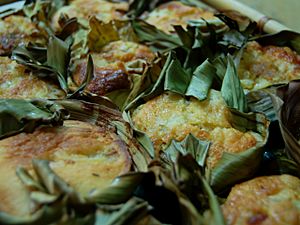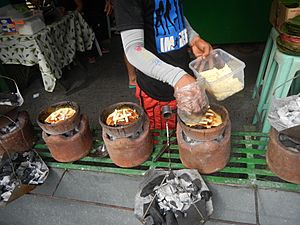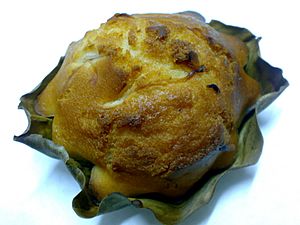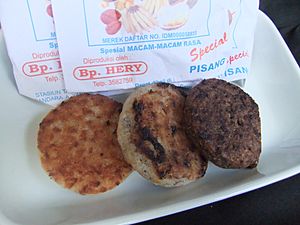Bibingka facts for kids
 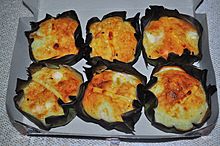 |
|
| Course | Dessert, Breakfast, Merienda |
|---|---|
| Place of origin | Philippines |
| Serving temperature | Hot or warm |
| Main ingredients | Glutinous rice (galapóng), water or coconut milk |
| Variations | Salukara, Cassava cake, Bibingkang Malagkit |
| Similar dishes | panyalam, puto |
Bibingka (pronounced bi-BEENG-kah) is a yummy baked rice cake from the Philippines. People traditionally cook it in a special clay oven lined with banana leaves. It's often eaten for breakfast or as a mid-afternoon snack, especially around Christmas.
The word Bibingka can also mean other Filipino baked treats. For example, some are made with cassava flour, while others use sticky rice or regular flour.
You can also find Bibingka in East Timor and some Christian areas in eastern Indonesia.
Contents
The Story of Bibingka
Bibingka from the Philippines and Indonesia likely share a common past. This is because the Indonesian bibingka comes from areas close to the Philippines. These regions also have very similar cultures.
Some people thought the Goan dessert bebinca might be related to bibingka because their names sound alike. They wondered if the Portuguese brought it to Southeast Asia from Goa. However, this is probably not true. The Philippines, where bibingka is most famous, was never a Portuguese colony.
Also, the two dishes are made very differently. The Goan bebinca is a layered coconut pudding, like the Filipino sapin-sapin. But Filipino bibingka is a baked sticky rice cake. The only thing they share is using coconut milk. Rice dishes are also much more common in Southeast Asia, where rice has been a main food for a very long time.
It's more likely that the Portuguese learned the word from the Philippines and took it to Goa. This is similar to how windowpanes made from oyster shells were brought from the Philippines to Goa. They are still called capiz in Goa, named after the Philippine province of Capiz.
Bibingka in the Philippines
Bibingka is a special Philippine food, especially during Christmas. People often eat it with puto bumbóng after attending the nine-day Simbang Gabi (Night mass). You can usually find it sold near churches during this time. In some towns like Baliuag and San Miguel, Bulacan, bibingka is even served with free fresh salabat (ginger tea).
On October 9, 2007, the town of Dingras, Ilocos Norte in the Philippines made a huge cassava bibingka. It was a kilometer long and used 1,000 kilos of cassava! About 1,000 people ate it, and the town hoped to get a Guinness World Records certification for it.
How Bibingka is Made
The old way to make bibingka starts with soaking sticky rice in water overnight. This allows it to ferment with natural yeast or tuba palm wine. The soaked rice is then ground into a smooth batter called galapong using a millstone. This fermentation helps the cake rise and gives it a unique, slightly fermented taste.
Because the traditional method takes a lot of time, modern recipes often use regular rice flour or Japanese mochiko flour instead of galapong. Other ingredients like eggs and milk are also commonly added.
To cook bibingka, a shallow clay bowl is lined with a large banana leaf. The bowl is placed over hot coals. The rice flour mixture is poured into the banana leaf, making sure it doesn't spill into the bowl itself.
Slices of salted egg and cheese are then placed on top of the batter. Sometimes, other toppings like pinipig (pounded young rice), chocolate, fruit jams, or pineapple are used. A mix of two or more toppings is common and is sometimes called bibingka especial.
Another banana leaf is placed on top, and the bowl is covered with a metal sheet holding more hot coals. The finished bibingka is a soft, spongy, flat cake. It's slightly browned on both sides and has a special smell from the toasted banana leaves. More toppings are added, usually butter, sugar, cheese, or grated coconut.
Today, many people use metal cake pans and electric ovens to make bibingka. This way, the cake doesn't have the smoky smell of charcoal, but it tastes and feels the same. This is especially true if banana leaves are still used to line the pans. Bakeries often make bibingka in tin molds that give them a wavy edge, like large puto or cupcakes.
Taste and Texture
Bibingka can be soft and spongy, like another Filipino rice cake called puto. Or it can be soft but a bit firmer. It's best eaten hot or warm and tastes slightly sweet, similar to rice pudding. The top and bottom, including the banana leaf, are usually a little charred. This adds to its unique flavor.
A regular-sized bibingka can be cut into several pieces and is usually enough for 3 to 4 people. Some places also offer smaller bibingka for one person.
Bibingka Varieties
Bibingka is also a general name for desserts baked in a similar way. It can loosely mean "rice cake." The original and most common type is bibingka galapong, made with rice flour. Other Filipino cakes are sometimes called bibingka too. These might use different flours like corn, cassava, or plain flour. They are often seen as separate dishes. Some bibingka types only differ by their toppings. Here are some common kinds of bibingka:
- Bibingka galapóng is the classic bibingka. It's made from ground soaked glutinous rice (galapóng), water, and coconut milk.
- Bibingkang malagkít is a moist bibingka, often cut into squares. It usually has slices of ripe jackfruit and is topped with latik (coconut caramel) and grated coconut. It's similar to biko, but it's baked and uses galapong.
- Bibingkang Mandaue comes from Mandaue, Cebu. It traditionally uses tubâ (palm wine), which gives it a slightly sour taste. Today, tubâ is often replaced with yeast.
- Bibingkoy is a unique type from Cavite. It has a sweet mung bean filling and is served with a sauce made from coconut cream, jackfruit, and sago. It's like mache, but it's baked instead of steamed.
- Buko bibingka is Bibingka baked with thin pieces of young coconut meat (buko).
- Cassava cake is made from grated cassava instead of rice. It uses coconut milk and condensed milk. It looks the most like a pudding. It's also called cassava bibingka or bibingkang kamoteng kahoy.
-
- Cassava buko bibingka is a version of cassava cake that includes young coconut (buko).
- Pineapple cassava bibingka is a cassava cake that has crushed pineapple pieces.
- Royal bibingka is a cassava cake from Vigan, Ilocos Sur. It's shaped like cupcakes and topped with cheese and margarine.
- Durian bibibngka is Bibingka baked with durian fruit. It's a special treat from the Davao Region in Mindanao.
- Salukara is a pancake-like bibingka from Eastern Samar. It also uses tubâ and is traditionally cooked in pans greased with pork lard.
- Sinukat is a type of bibingka baked inside half of a coconut shell.
Bibingka in Eastern Indonesia
Bibingka or bingka is also popular in Indonesia. You'll find it especially in Christian areas in northern Sulawesi and the Maluku Islands. Both of these places were once colonies of the Portuguese Empire and are close to the southern Philippines. It's made almost the same way as Philippine bibingka.
In North Sulawesi and Gorontalo, bibingka is usually made with rice or cassava flour and coconut milk. It often has shredded coconut baked inside. In the Maluku Islands, bibingka is spiced and sweetened with brown sugar or sweet meat floss. It's also traditionally cooked in clay pots lined with banana, pandan, or nipa leaves. Just like in the Philippines, it's often eaten during the Christmas season.
A pancake-like version of bibingka was brought to the Chinese Indonesian communities in East Java during the time of the Dutch East Indies. This version is known as wingko, wiwingka, or bibika, and it became popular all over the island of Java.
Indonesian Varieties
- Bibingka kelapa or bibingka santan is Indonesian bibingka made from rice flour and coconut milk. It's topped with jackfruit or coconut.
- Bibingka abon is made from rice flour and coconut milk, topped with meat floss.
- Bibingka ubi telo is made from ube or cassava flour and coconut milk.
- Bibingka nanas or wingko nanas is made from ube or cassava flour and coconut milk with pineapple.
Images for kids
-
Bibingka from Baliuag, Bulacan topped with salted duck eggs and grated coconut
-
Bibingka from Mindanao
-
Bibingkang kamoteng kahoy, better known as cassava cake, a variant made from cassava
See also
 In Spanish: Bibingka (Filipinas) para niños
In Spanish: Bibingka (Filipinas) para niños


